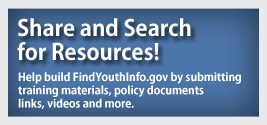Integrating Positive Youth Development into Programs
Positive youth development can be integrated into any youth development program. First and foremost, all youth serving organizations should work towards assuring that young people have the chance to develop across all aspects of their lives in order to acquire the most positive experience possible. Positive youth development strategies include giving youth access to experiences that build leadership, boost self-awareness, and connect youth to caring adults.
A comprehensive review of the research literature focused on community programs for youth (Eccles & Gootman, 2002), identified key environmental factors and experiences that have been found to promote positive youth development. They include:
Physical and Psychological Safety
A program should provide ground rules that are developed and posted by the youth participants. Adequately trained staff members who understand respect are essential to prevent bullying and hazing situations. A program should also include youth and adults trained in team building who can understand and recognize symptoms of cliques and find alternative means for using group and team-building exercises.
A program should provide appropriate youth-to-adult ratios for supervision, a system for ensuring youth are welcomed when they arrive, and a balance for different learning styles in programmatic activities.
Programs should create opportunities where youth share and interests are known and provide trained staff in handling conflict, recognizing symptoms of withdrawal, and understanding how to engage youth without singling them out.
A program should provide opportunities for youth to be engaged in small group activities based upon interest, and structured team building should be provided to ensure all youth have a chance to get acquainted. To feel involved, opportunities for sharing need to be incorporated into each and every activity.
Programs should engage youth in creating a respectful environment and involve a respect for diversity and culture in activities.
Opportunities to Make a Difference
A program should engage youth in exploring career and workforce opportunities, provide occasions for goal setting, and create opportunities to make a difference in service learning or peer support.
Opportunities for Skill Development
Programs should provide opportunities to master and apply skills, and should engage youth in determining choices toward progression of new levels of learning.
Integration of Family, School, and Community Efforts
A program needs to incorporate ways to engage parents and/or guardians, staff, and youth participants either through family activities, newsletters, websites, and program policies. Programs should be aware of when youth are in or out of school and plan accordingly to support youth and their families in extended programming opportunities.
These key environmental factors help a program in considering where to hold the program, how to train the staff, foster relationships and create ways for youth to belong and be engaged, administer appropriate discipline, structure learning and skill mastery, and integrate youth's contexts of family, peers, school, and community. Again, the reduction of risk and the increase of resiliency along with caring relationships will foster positive youth development.
Eccles J. S., & Gootman J. A. (Eds.). (2002). Community programs to promote youth development. Washington, D.C.: National Academy Press.
Resources
Runaway and Homeless Youth Training and Technical Assistance Center
This is a centralized national resource for Runaway and Homeless Youth (RHY) grantees funded by the Family and Youth Services Bureau at HHS. Training and Technical Assistance Services are directed at assisting RHY grantees to engage in continuous quality improvement of their services and to build their capacity to effectively serve runaway and homeless youth.
Family and Youth Services Bureau Administration for Children and Families, U.S. Department of Health and Human Services
The mission of the Family and Youth Services Bureau (FYSB) is to provide national leadership on youth and family issues. FYSB promotes positive outcomes for children, youth, and families by supporting a wide range of comprehensive services and collaborations at the local, Tribal, state, and national levels. Grant programs supported by FYSB include the Mentoring Children of Prisoners Program, Runaway and Homeless Youth Programs, and Family Violence Prevention and Services.
Building Partnerships for Youth
Building Partnerships for Youth is a partnership between the National 4-H Council and the University of Arizona designed to build the capacity of youth-serving organizations in the fields of education, health, faith, and youth development to facilitate the intentional integration of youth development concepts and approaches into policies and programs.
National Initiative to Improve Adolescent Health
The National Initiative to Improve Adolescent Health (NIIAH or the National Initiative) is a collaborative effort to improve the health, safety, and well-being of adolescents and young adults ages 10–24 years. The National Initiative was launched and is led by Division of Adolescent and School Health, Centers for Disease Control and Prevention and Maternal and Child Health Bureau, Health Resources and Services Administration and supported by a group of partner organizations. Find a range of resources including a guide for state agencies and local organizations on their website.
Youth Topics
Collaboration Profiles
Briefs
Youth Voices
Feature Articles
Tools & Guides
Programs
Technical Assistance
Websites
Publications
Videos & Podcasts


Announcements

Map My Community is a tool designed specifically to assist you in locating resources in your community to help you build and strengthen your youth program. Get ideas for new partnerships, identify gaps in your community, and learn about resources to avoid duplication of effort.



















